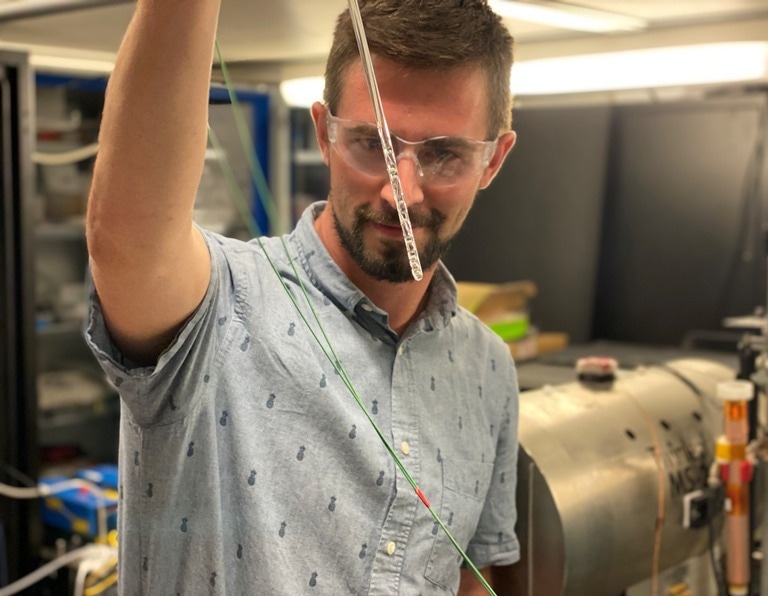Magnetic resonance imaging, which is utilized in medicine for diagnostic purposes, is one of the many analytical applications of nuclear magnetic resonance (NMR). However, NMR’s application is frequently constrained by the need to produce strong magnetic fields.

Dr. Danila Barskiy experimenting. Image Credit: photo/©: Danila Barskiy
Scientists at the Helmholtz Institute Mainz (HIM) and Johannes Gutenberg University Mainz (JGU) have now identified possible new approaches to decrease the size of the corresponding devices as well as the possible risk involved by doing away with the requirement for powerful magnetic fields. This is accomplished by coupling a unique hyperpolarization approach with so-called zero- to ultralow-field NMR.
This exciting new method is based on an innovative concept. It opens up a whole range of opportunities and overcomes previous disadvantages.
Dr Danila Barskiy, Helmholtz Institute Mainz
Dr. Barskiy was also a Sofja Kovalevskaja Award winner who has been working in the relevant discipline at JGU since 2020.
New Approach to Enable Measurements without Strong Magnetic Fields
Due to the magnets, the present generation of NMR apparatus is incredibly bulky and expensive. The current shortage of liquid helium used as a coolant is another aggravating element.
“With our new technique we are gradually moving ZULF NMR towards a status of being completely magnet-free, but we still have many challenges to overcome,” stated Barskiy.
Barskiy’s concept of combining zero- to ultralow-field nuclear magnetic resonance (ZULF NMR) with a unique method that allows for the hyperpolarization of atomic nuclei eliminates the need for magnets in this situation. Even ZULF NMR, a newly formed type of spectroscopy, yields a wealth of analytical data without the use of strong magnetic fields.
The ability of low-field NMR to identify signals amid conductive materials, such as metals, gives it another benefit over high-field NMR. The sensors used for ZULF NMR are usually optically pumped magnetometers, which are extremely sensitive, user-friendly, and already obtainable in the market. A ZULF NMR spectrometer can therefore be put together fairly easily.
SABRE-Relay: Transferring Spin Order like a Baton
However, there is a problem to be solved with the generated NMR signal. Only a small number of compounds can be analyzed using the procedures that have been utilized up to now to generate the signal, and they come with astronomical expenses.
Barskiy has chosen to make use of the SABRE hyperpolarization technology, which enables the alignment of many nuclear spins in solution. Several such methods could generate a signal strong enough to be detected in ZULF circumstances.
One of them is SABRE, which refers to Signal Amplification by Reversible Exchange and has proven to be quite effective.
An iridium metal complex that enables the transfer of the spin phase from parahydrogen to a substrate is essential to the SABRE method.
Barskiy has used SABRE-Relay, a relatively new advancement of the SABRE approach, to get over the drawbacks brought on by the sample’s transient binding to the complex. In this instance, polarisation is induced via SABRE and then transmitted to a secondary substrate.
Spin Chemistry at the Interface of Physics and Chemistry
In their paper published in Science Advances, Dr. Danila Barskiy, main author Erik Van Dyke, and their co-authors describe how they were able to identify methanol and ethanol signals retrieved from a vodka sample.
This simple example demonstrates how we have been able to extend the application range of ZULF NMR with the help of an inexpensive, rapid, and versatile method of hyperpolarization.
Dr Danila Barskiy, Helmholtz Institute Mainz
“We hope that we’ve managed to get a little closer to our objective of making feasible the development of compact, portable devices that can be used for the analysis of liquids such as blood and urine and in future, possibly endowing discrimination of particular chemicals such as glucose and amino acids,” summarized Barskiy.
Journal Reference
Dyke, E. T. V. et al. (2022) Relayed hyperpolarization for zero-field nuclear magnetic resonance. Science Advances. doi.org/10.1126/sciadv.abp9242.